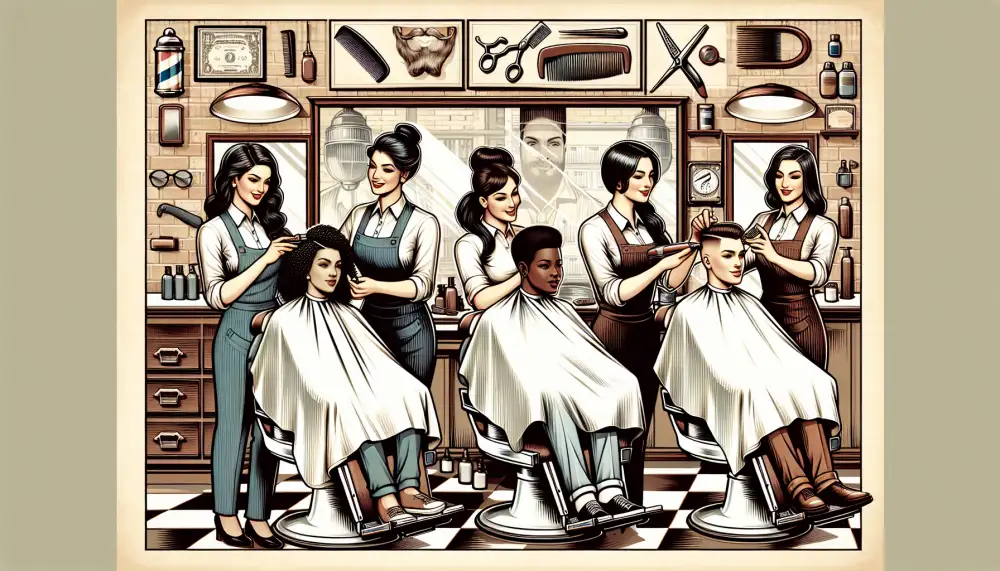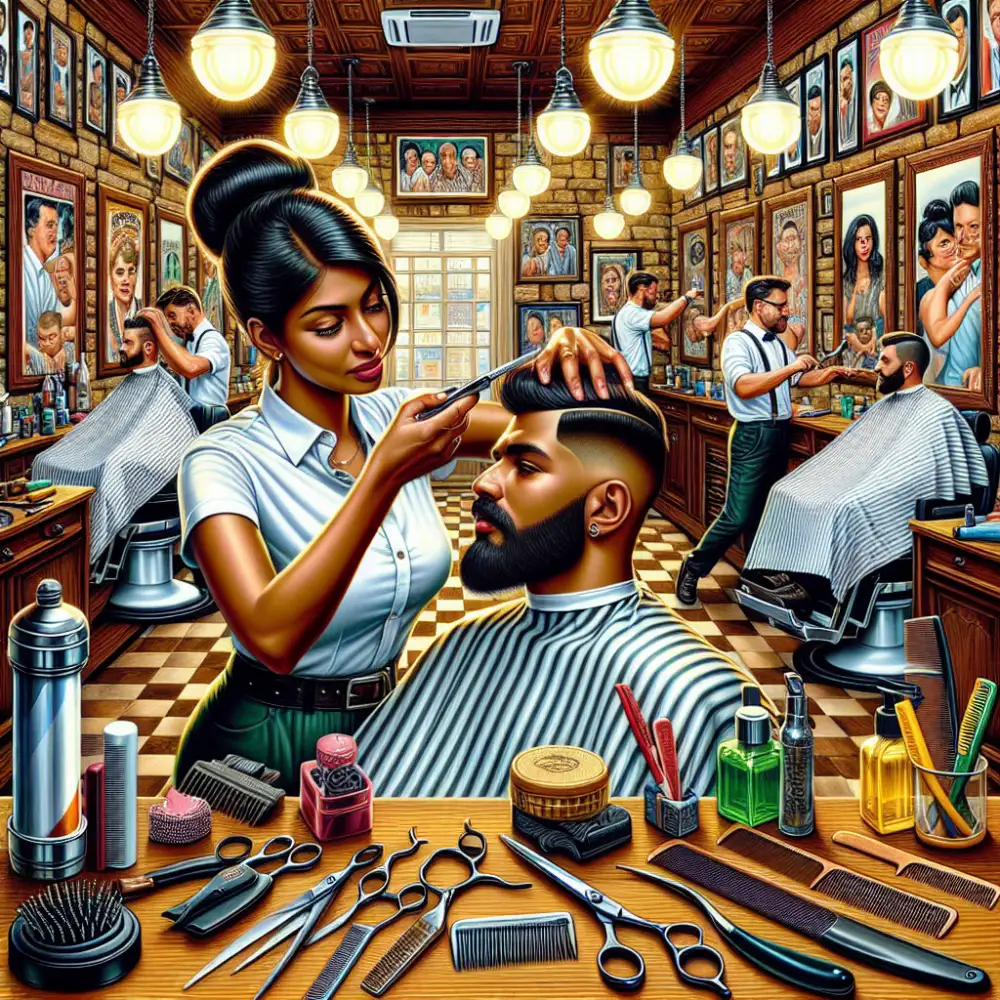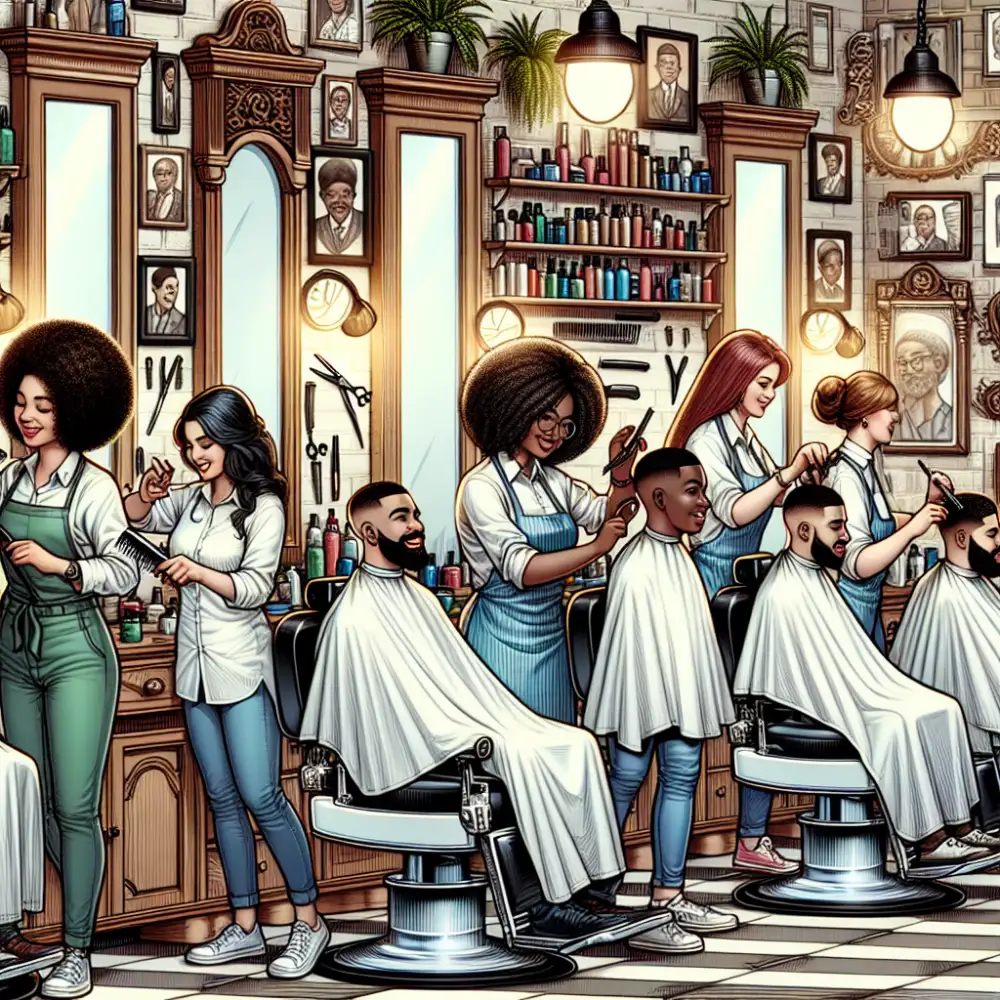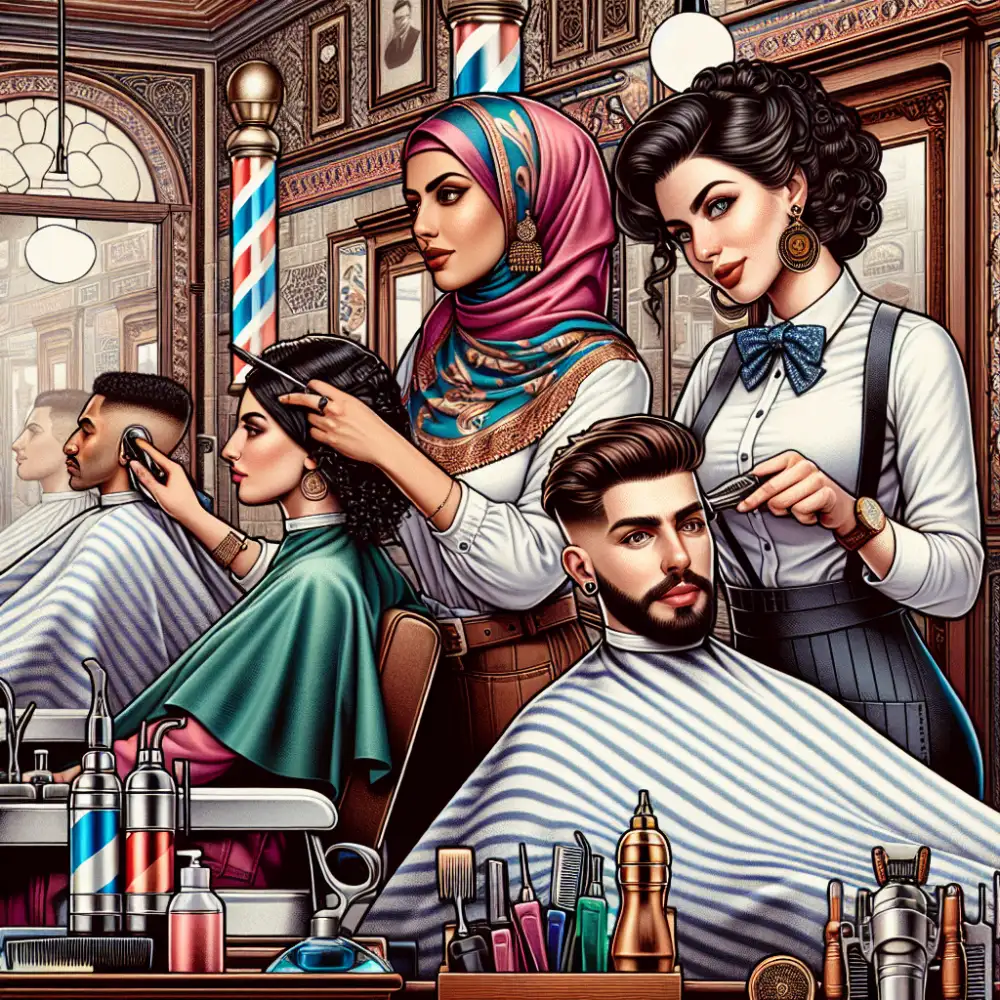Women Barbers: The Rise of Female Groomers

History of women barbers
The history of women barbers is a long and fascinating one, dating back to ancient civilizations. For centuries, women have played a vital role in hair care and grooming, though their contributions have often been overlooked or minimized.
In ancient Egypt, women worked as barbers, serving both men and women. They were highly skilled in creating elaborate hairstyles, using natural ingredients like henna and beeswax. These skilled artisans held respected positions, evidenced by depictions in art and artifacts.
During the Middle Ages in Europe, barbering became increasingly male-dominated, largely due to the influence of barber guilds. These guilds often excluded women from membership, limiting their opportunities. However, women continued to practice hair care within their homes and communities, passing down their knowledge through generations.
The 18th and 19th centuries saw a resurgence of women in the barbering profession. As demand for barbering services grew, women established their own shops and salons, catering specifically to female clientele. This era marked a turning point, as women began to reclaim their space in the industry.
The early 20th century brought about further changes, with the invention of new tools and techniques like the safety razor and permanent waving. Women embraced these innovations, further solidifying their role as skilled professionals.
However, societal expectations and gender norms continued to pose challenges. Women barbers often faced discrimination and were sometimes relegated to performing more "feminine" services, like shampooing and styling, rather than cutting or shaving.
Despite these obstacles, women persevered, and their contributions to the barbering world continued to grow. The latter half of the 20th century saw a rise in women's rights movements, leading to greater opportunities and recognition for women in traditionally male-dominated fields, including barbering.
Today, women are an integral part of the barbering industry, working alongside men as skilled professionals. They own and operate barbershops, compete in prestigious competitions, and are recognized leaders in the field. From traditional barbering techniques to modern hairstyling, women are breaking down barriers and leaving their mark on the ever-evolving world of hair care.
Breaking stereotypes
For generations, the barbershop has been perceived as a predominantly male domain. The striped pole, the leather chairs, the conversations about sports and cars – all seemed to cater to a masculine clientele. But times are changing. A new generation of barbers is breaking down stereotypes and proving that the artistry and skill of barbering know no gender. These women are not just cutting hair, they are challenging perceptions and reshaping the industry.

One of the biggest hurdles women barbers face is the deeply ingrained societal perception of barbering as a "man's job." Many women barbers have stories of surprised customers, skeptical family members, and even outright discouragement. But these barbers are resilient. They are passionate about their craft and refuse to be defined by outdated stereotypes.
And it's not just about proving the doubters wrong. These women are drawn to barbering for the same reasons as their male counterparts: the creativity, the artistry, the satisfaction of helping people look and feel their best. They find joy in the precision of a fade, the artistry of a beard trim, and the connection they build with their clients.
The rise of women barbers is not just a win for gender equality, it's also a positive shift for the industry as a whole. Their presence brings a fresh perspective, a different energy, and often, a new level of attention to detail that many clients appreciate. They are also expanding the barbershop experience, making it more inclusive and welcoming to a wider range of clientele.
This inclusivity is particularly important in today's world, where men's grooming is no longer a one-size-fits-all concept. Men are embracing diverse styles, from classic cuts to modern fades and everything in between. Women barbers, with their diverse training and experiences, are uniquely positioned to cater to this growing demand for personalized grooming.
The journey isn't always easy. These women often have to work harder to prove themselves in a male-dominated field. But their passion, dedication, and undeniable talent are paving the way for future generations of barbers. They are showing the world that the barbering industry is a place for anyone with a steady hand, an eye for detail, and a passion for the craft. The future of barbering is inclusive, it's diverse, and it's looking sharper than ever.
Unique challenges faced
Women barbers and female professionals in the hair and grooming industry face a unique set of challenges compared to their male counterparts.
One of the biggest hurdles is overcoming gender stereotypes. Historically, barbering has been a male-dominated field, and some clients may still harbor unconscious biases. This can manifest as skepticism towards a woman's skills or a preference for male barbers. Building a loyal clientele and gaining recognition for their expertise can be an uphill battle for women.
Another challenge is the perception of physical strength. Some clients believe that men are stronger and therefore better equipped to handle certain tools or techniques. This is a misconception, as women barbers are just as capable as men when it comes to technical skills and precision.
The industry's culture can also present challenges. Women may encounter a lack of female mentors or role models, making it harder to navigate the industry and its unwritten rules. The prevalence of "locker room talk" and a male-dominated environment can also be alienating for women.

Work-life balance is another significant concern. Many barbershops operate on evenings and weekends, which can conflict with family commitments. Women, often the primary caregivers in their families, may struggle to balance the demands of their profession with their personal lives.
Access to funding and resources can also be a challenge. Women entrepreneurs in the barbering industry may face difficulty securing loans or investments to start their own businesses. This can limit their growth potential and make it harder to compete with established, often male-owned, barbershops.
Despite these challenges, women are making significant strides in the barbering world. More and more women are entering the profession, challenging stereotypes, and carving out their own spaces. Through their talent, perseverance, and dedication to their craft, they are proving that barbering is a gender-neutral profession. As the industry evolves, it's crucial to recognize and address these unique challenges to create a more inclusive and equitable environment for all barbers, regardless of gender.
Benefits of choosing them
Choosing a female barber or stylist offers a unique set of benefits that can enhance your grooming experience. Here are compelling reasons to consider putting your trust in their capable hands:
Women often possess a keen eye for detail, which translates to precision haircuts and meticulous beard trims. They understand the nuances of different hair types and textures, ensuring a customized approach tailored to your specific needs.
Communication is key to a successful grooming experience. Female barbers and stylists are known for their excellent listening skills and ability to understand your desired look, even if you're not sure how to articulate it. They'll take the time to discuss your preferences and offer expert advice.
Many men find the atmosphere in a barbershop or salon run by women to be more welcoming and relaxing. The vibe tends to be less intimidating and more focused on creating a comfortable and enjoyable experience for all clients.
Female barbers and stylists are skilled in a wide range of grooming services beyond just haircuts. They can provide expert beard trims, shaves, facials, and other treatments that can help you look and feel your best.
In a traditionally male-dominated industry, choosing a female barber or stylist is a way to support women in business and champion gender equality. Your patronage can make a difference in their professional journey.
Ultimately, the decision of who to trust with your grooming needs is personal. However, the benefits of choosing a female barber or stylist are undeniable. Their attention to detail, communication skills, welcoming demeanor, and diverse skill set make them a valuable asset to the grooming industry. So, next time you're looking for a fresh cut or a relaxing shave, consider giving a talented female professional a try. You might be pleasantly surprised by the experience.


Tips for aspiring barbers
The world of barbering is no longer a boys' club. More and more talented women are picking up the clippers and making their mark on the industry. So, if you're a woman considering a career as a barber, know this: you belong here! Your unique perspective and skills are incredibly valuable.
First things first, hone those skills. Enroll in a reputable barber school. You'll build a strong foundation in everything from classic cuts to modern styles, and of course, the all-important beard trims. A solid education is key to building confidence and attracting clients.
Network like your career depends on it, because it kind of does. Attend industry events, workshops, and hair shows. Connect with other barbers, potential mentors, and even future employers. Building relationships is essential in this industry.
Find your niche and rock it. Whether it's precision fades, creative designs, or specializing in services for women with textured hair, identify what sets you apart and own it. This will help you stand out in a competitive market.
Social media is your friend. Use platforms like Instagram and TikTok to showcase your work, connect with potential clients, and build your brand. High-quality photos and engaging content can make all the difference.
Remember, barbering is about more than just cutting hair. It's about building relationships with your clients. Listen to their needs, offer expert advice, and create a welcoming and inclusive atmosphere in your barbershop.
Don't be afraid to break the mold. The industry is evolving, and there's room for you to make your mark. Embrace your creativity, challenge the status quo, and never stop learning and growing.
Notable women barbers
Women have been styling and cutting hair for centuries, often behind the scenes or in domestic settings. However, the 20th and 21st centuries saw a significant rise in women breaking into the professional barbering world. These women not only mastered the skills of the trade but also challenged gender norms and paved the way for future generations.
One notable figure is Helena Rubinstein. While known as a cosmetics mogul, her journey began in the early 1900s with her passion for skincare and extended to haircare. Recognizing the need for quality hair products and services, she opened salons that offered cuts, styling, and treatments. Her entrepreneurial spirit and innovative approach to beauty made her an icon.

The latter half of the 20th century witnessed a surge in women entering traditionally male-dominated fields, and barbering was no exception. Madam C.J. Walker, though not a barber herself, laid the groundwork for Black women in the beauty industry. Her early 1900s haircare line, specifically catering to Black hair, was revolutionary. This paved the way for Black women to establish salons and barber shops, fostering economic independence and community spaces.
Today, the landscape continues to evolve. Organizations like the National Association of Barber Boards and Professional Beauty Association work towards inclusivity and provide resources for women in the industry. Social media platforms have become powerful tools, allowing female barbers to showcase their artistry, connect with clients, and build their brands.
The story of women in barbering is one of resilience, artistry, and entrepreneurship. From pioneers like Rubinstein to the countless women shaping the industry today, they challenge stereotypes and redefine success on their own terms. Their influence is undeniable, inspiring aspiring barbers and proving that the barbering world is a space for everyone with a passion for the craft.
Future of women barbers
The future of women barbers is shining bright, with more and more women breaking into this traditionally male-dominated field. This surge in female barbers is driven by several factors. Clients feel more comfortable discussing their desired styles and preferences with women, leading to a more personalized and enjoyable experience. The rise of social media has provided a powerful platform for women barbers to showcase their skills and creativity, attracting new clients and inspiring others.
Women are embracing entrepreneurship and opening their own barber shops, creating welcoming and inclusive spaces for all genders. This shift in demographics is also changing the industry itself. Barbering schools and training programs are seeing a significant increase in female enrollment, reflecting a growing interest among women in pursuing this career path.
The industry is recognizing and celebrating the talent and artistry of women barbers. Major barbering competitions and events now feature dedicated categories for women, providing them with a platform to showcase their skills and compete on an equal footing. Established barbering brands are collaborating with and featuring more women in their marketing campaigns and product lines, acknowledging their growing influence and appeal to a wider customer base.
This trend towards greater inclusivity and diversity is not only positive for women barbers themselves but for the industry. A new generation of skilled and passionate barbers is emerging, bringing fresh perspectives, creativity, and a commitment to providing exceptional grooming experiences for all. The future of women barbers is bright, and their contributions are shaping the future of the barbering industry itself.
Published: 23. 06. 2024
Category: lifestyle



